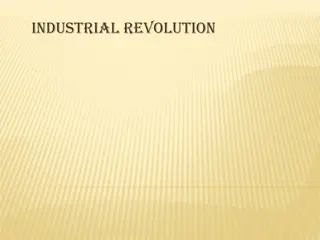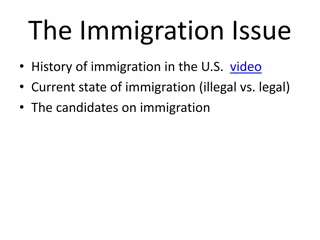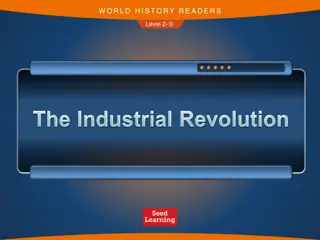The Market Revolution and its Impact on Immigration, Nativism, and Inventions
The Market Revolution brought significant changes to American society, including the shift from subsistence farming to cash-crop farming, regional specialization, and the growth of cities. Immigration surged in the 1840s and 50s due to factors such as the Irish potato famine, leading to nativist sentiments and the rise of the Know-Nothing Party. The era also saw advancements in inventions like the cotton gin, interchangeable parts, and the steel plow, shaping the industrial landscape of the time.
Download Presentation

Please find below an Image/Link to download the presentation.
The content on the website is provided AS IS for your information and personal use only. It may not be sold, licensed, or shared on other websites without obtaining consent from the author.If you encounter any issues during the download, it is possible that the publisher has removed the file from their server.
You are allowed to download the files provided on this website for personal or commercial use, subject to the condition that they are used lawfully. All files are the property of their respective owners.
The content on the website is provided AS IS for your information and personal use only. It may not be sold, licensed, or shared on other websites without obtaining consent from the author.
E N D
Presentation Transcript
What was the Market Revolution? Industrial Revolution Transportation Revolution: roads, canals, steamboat, railroad Change from subsistence farming to large-scale cash- crop farming. Regional specialization: East, West and South Immigration: Irish and German (U.S. need for labor) Westward movement Growth of cities
Immigration 1840s and 50s immigration skyrockets, why? Land of freedom and opportunity Abundance of land in US Disease Mid 1840s, potato famine strikes Ireland of country dies due to disease/hunger Black Forties Period when many Irish died/emigrated to other countries Most lived in cities, not enough $ to move west Jobs: NINA Canal workers Erie Canal Hated by Native Americans for stealing jobs due to low wages Become a powerful political force: patronage, voting Democrats Largest group of immigrants from 1830 to Civil War
Nativism Nativists Hated foreigners, fear of losing culture, jobs, etc. Religious Fears Many Irish were catholic, fear that would infringe on Protestantism Order of the Star Spangled Banner, Know- Nothing Party Political party that hoped to: Restrict immigration and naturalization laws
Inventions and Inventors Samuel Slater: Father of Factory System Memorizes plans for machines, sneaks to US Eli Whitney: Created Cotton Gin, 50 times more effective than handpicking Impacts of cotton gin: Dependence on slavery which had been dying out Factory system in north to create clothes
Inventions Continued Due to embargos, Americans encouraged to Buy American and Wear American Treaty of Ghent in 1815 opens up trade again, GB floods US with cheap products US response? Tariff of 1816, first protective tariff Who will like this? Who will hate this? Interchangeable Parts: Invented by Eli Whitney, machines produce identical parts, if a part breaks, it can easily be replaced John Deere: Invented steel plow that broke soil Cyrus McCormick Mechanical mower-reaper
Factory Life Factory life stunk Long hours, low pay, child labor, whipping rooms Lowell Girls: Farmers daughters hired to work in factories Significance of factories: Change in manufacturing from home to factories 1840: MVB establishes 10 work day for federal employees Strikes were illegal and rare, but did happen Commonwealth v. Hunt: Massachusetts Supreme Court Decision: Labor unions legal, so long as they were not violent or subversive More symbolic than immediately significant.
Transportation Cheap and efficient carriers were imperative Why? Desire and need to tap resources of west Trade Lancaster Turnpike Connected Philadelphia to Lancaster, 62 miles Spurs construction of other roads By 1832, 2,400 miles of roads connecting major cities Robert Fulton Steam Engine, now boats could go in any direction
Clintons Big Ditch in NY Erie Canal: 363 miles from Buffalo to Albany Hudson River to Great Lakes Cost to ship grain fell from $100 to $5; 20 days to six Creation of many cities in NY, especially Lockport Inrastate commerce
Effects on the Union By Civil War, continental economy had emerged Division of Labor applied on a national scale South: Agriculture North/East: Factories West: Livestock























